- Wondering how to get Monopoly GO! free rolls? Well, you’ve come to the right place. In this guide, we provide you with a bunch of tips and tricks to get some free rolls for the hit new mobile game. We’ll …
Best Roblox Horror Games to Play Right Now – Updated Weekly
By Adele Wilson
Our Best Roblox Horror Games guide features the scariest and most creative experiences to play right now on the platform!The BEST Roblox Games of The Week – Games You Need To Play!
By Sho Roberts
Our feature shares our pick for the Best Roblox Games of the week! With our feature, we guarantee you'll find something new to play!Type Soul Clan Rarity Guide – All Legendary And Common Clans Listed!
By Nathan Ball
Wondering what your odds of rolling a particular Clan are? Wonder no more, with my handy Type Soul Clan Rarity guide.
Dandy Dungeon Tips, Cheats and Strategies
Dandy Dungeon is a wonderfully unusual dungeon crawling puzzler from Onion Games. In this often strange and hilarious game, players will help the main character, Yamada, develop his perfect video game by playing the levels he creates and watching as …
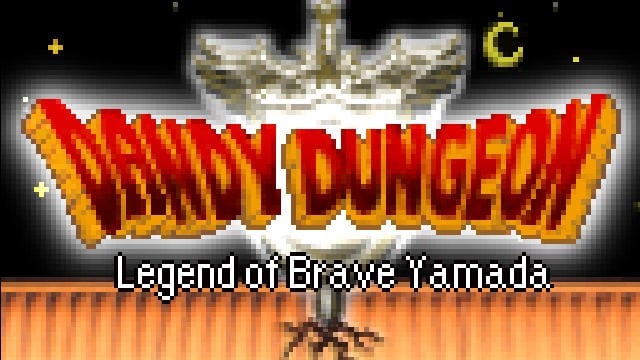
Dandy Dungeon is a wonderfully unusual dungeon crawling puzzler from Onion Games. In this often strange and hilarious game, players will help the main character, Yamada, develop his perfect video game by playing the levels he creates and watching as his real life story unfolds. Gamezebo’s Dandy Dungeon Tips, Cheats and Strategies will help get you started on the road to video game perfection, pet duck ownership, and true love.
Starting Out: Before you even begin playing Dandy Dungeon, it’s worth knowing that the game requires an additional install when you first open it. The final size of the game is 438 MB (at the time of this writing) and the initial install takes about 5-10 minutes depending on your connection. But you will probably want to be on Wi-Fi the first time you open it. There is also a separate Terms of Service that must be agreed to before playing which pops up after this install. This ToS discusses things like User IDs and passwords, although currently the game does not require either of these items, as well as standard terms for in-app purchases (no refunds), not committing criminal acts through the game, disclosure of personal information and the fact that the publisher will not use it for any purposes outside those stated, etc.
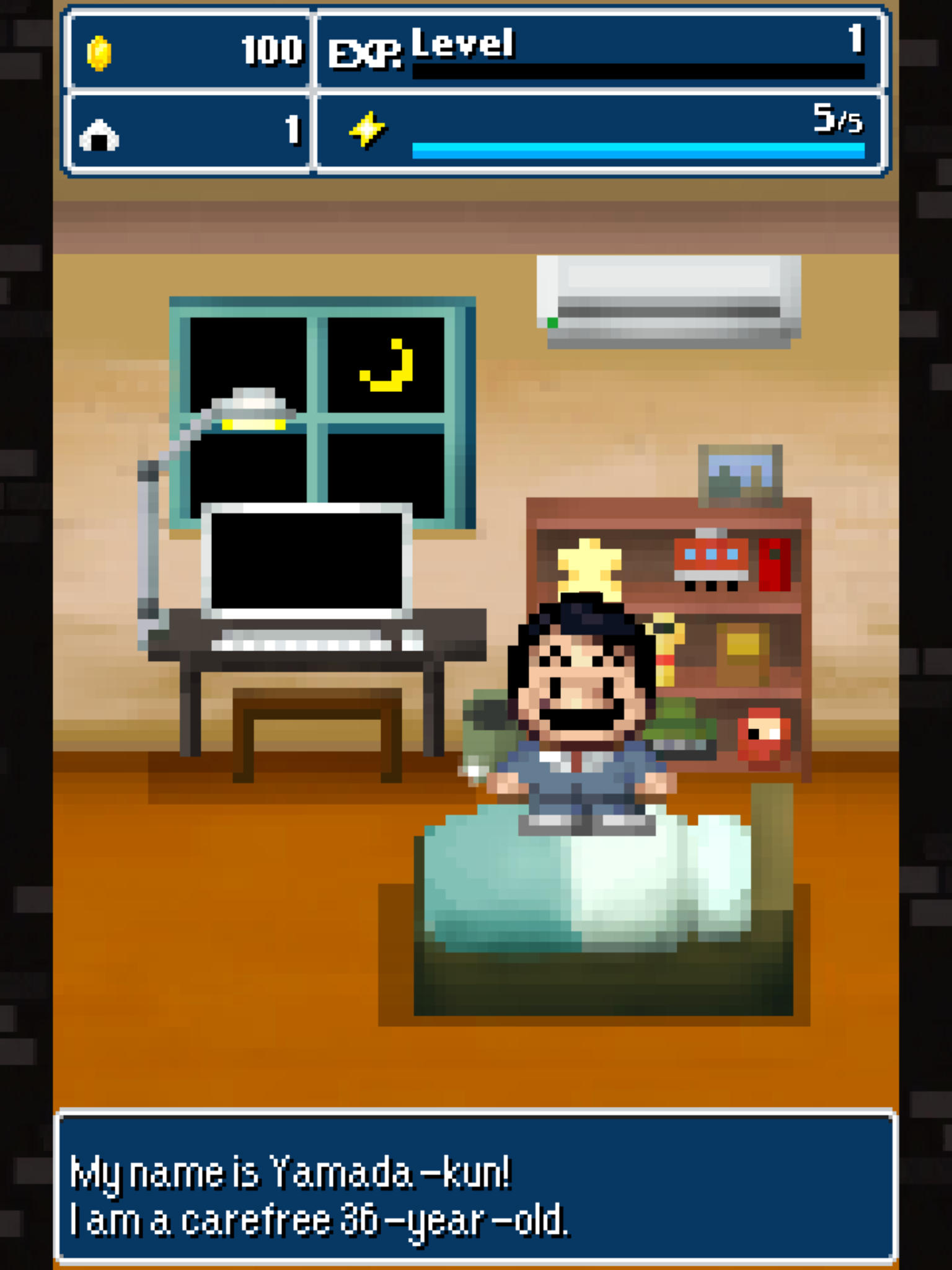
Okay, I’m in—what’s going on here? Once you get past all the start-up distractions and hit the “start” button, you’ll be taken to Yamada’s one-room apartment. Yamada will introduce himself—he’s a 36-year-old programmer at Empire Games Inc.—but he admits to hating his job and dreaming of staying home to make his own games. He decides to start his first game that minute, and hopes that you’ll help him in his new game-making journey.
Yamada’s initial instructions—“Just tap me a bunch! I’ll gain EXP! I’ll make progress on my game!”—makes it sound like Dandy Dungeon will be something of an idle clicker. This is misleading, however. For the first couple minutes, you will just be tapping and watching Yamada get the basics of his game in place. Once he tears off his clothes and settles in at his computer, you can tap him to watch him create his first character (a Knight version of himself), then an enemy and the basis of a dungeon.
Very soon, however, Yamada implements “DEBUG MENU” and you can start actually playing his game. This is where the more active gameplay of Dandy Dungeon resides.
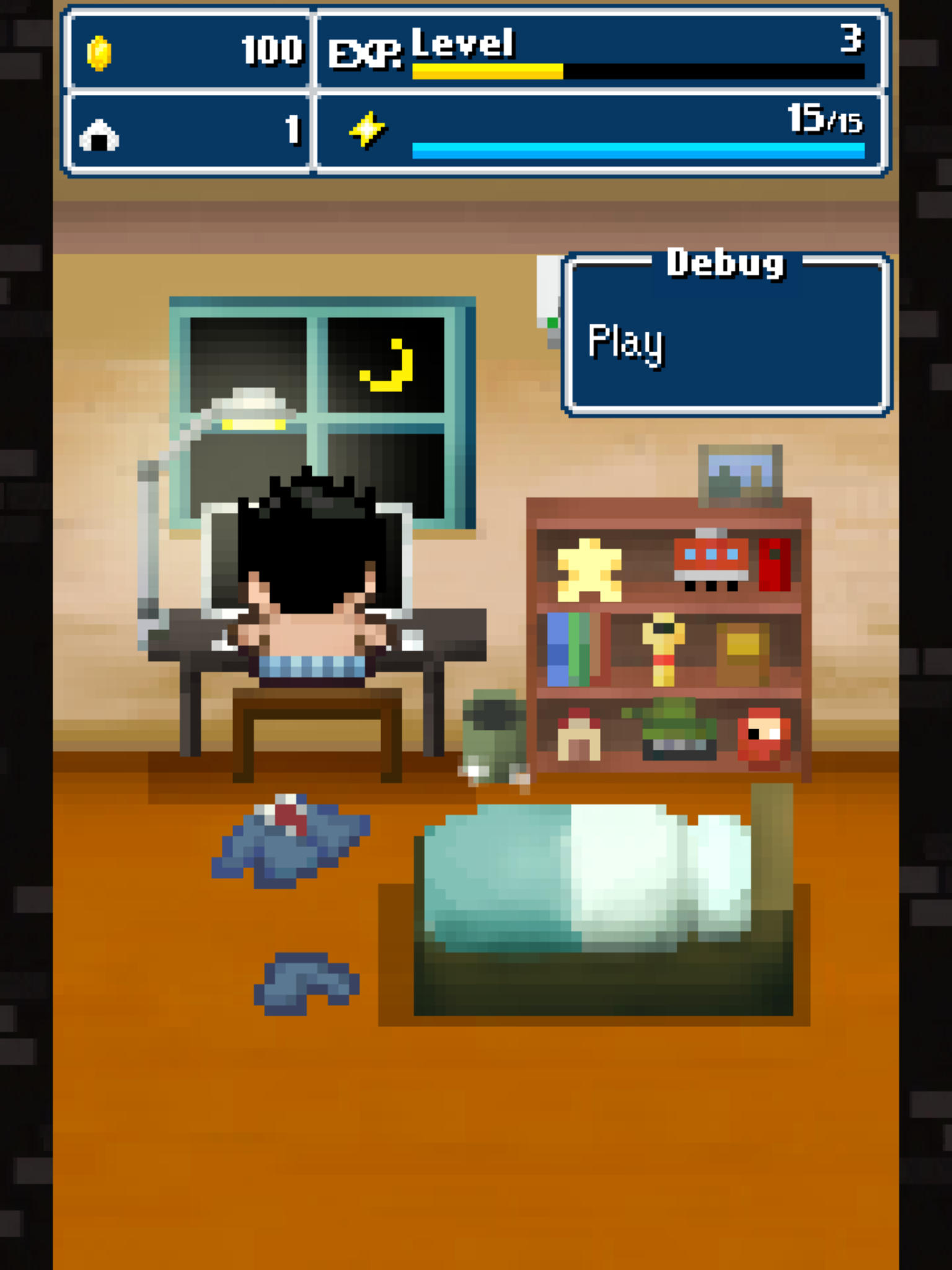
So what’s the main gameplay? Dandy Dungeon has two primary areas you’ll be interacting with. The first is Yamada’s apartment where you see him typing away at his computer. This is your base of operations which acts as the hub for entering the game, upgrading equipment, purchasing items, etc. This room offers a lot of information and many different menus: if you tap on Yamada himself, you’ll be given a list of options like “Schedule,” “Monster Shelf,” “Dandy Collections,” etc. These are all informative items: the Schedule shows you how far along in the game you are. The Monster Shelf tracks monsters you’ve encountered and details about them, like what items they drop. Dandy Collections displays any full equipment sets you’ve uncovered. And so on. You could technically beat the game without ever looking at any of these options, but they do provide useful info.
At the top of the apartment you will always see a box with four stats: coins, EXP level, rice balls, and energy. Coins are used to purchase and upgrade items, EXP allows Developer-Yamada to level up as a programmer and increases his maximum amount of energy, rice balls are the premium currency used for continuing if you die in a dungeon and other special tasks, and energy is used to actually play dungeon levels (and it refills automatically over time or if Yamada levels up).
On the bottom of the apartment screen are two faces: the face on the left will open the in-app purchase shop, Mamazon.mom. The face on the right will display news/announcements for Dandy Dungeon.
If you tap the bookshelf to the right of Yamada, you will open the “Debug” menu. At the beginning of Dandy Dungeon this menu will be very limited, with only “Play” listed. As you make progress, more options will be added. Choosing “Play” will let you actually play the game Yamada is creating. This is where the dungeon-exploring, item-collecting, enemy-bashing, and puzzle-solving aspects of the game take place. While the apartment area is mostly for character and equipment management, the dungeon plays are where the action occurs. We discuss these in greater detail below.
To exit a menu in the apartment, just tap anywhere outside of it, or hit the X on the Mamazon/Announcement boxes.
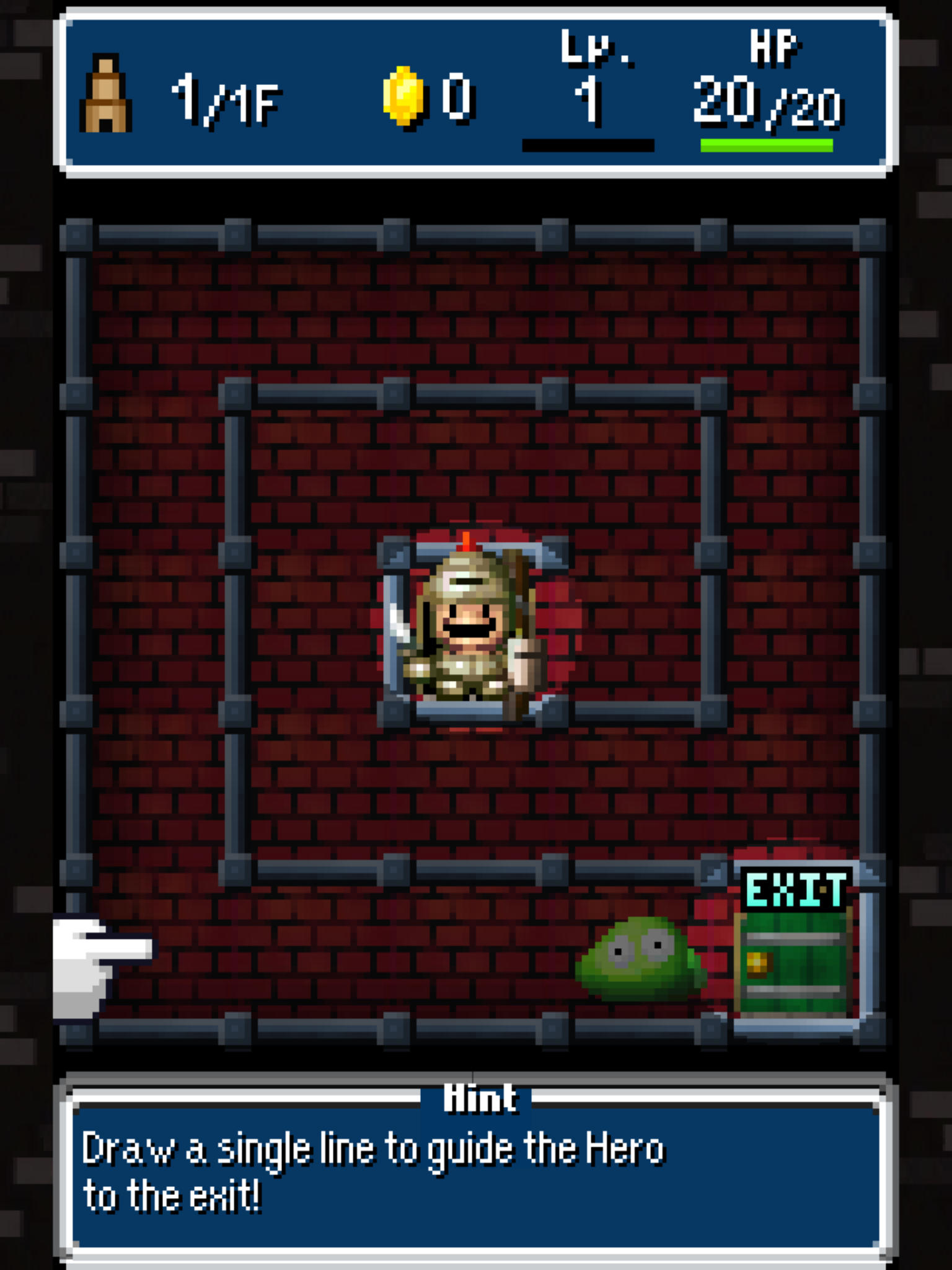
What’s going on in the dungeons? When you choose to “Play” from the Debug menu in Yamada’s apartment, you’ll enter the game he is developing. At the beginning of Dandy Dungeon, this game is extremely simple: it will feature a single dungeon with one floor, one enemy, etc. As you complete these stages, however, Yamada will implement more complex features and challenges in the game.
Yamada’s game is a dungeon crawler, but you cannot move Hero-Yamada (the in-game version of himself) directly. In order to send him through the dungeon, you’ll need to draw a line from his starting point to the door marked “Goal.” Anything the line intersects along the way will be interacted with by Hero-Yamada. So, if your line cuts through a monster, he will fight that monster. If it intersects a treasure chest, he will pick up that treasure chest. If it goes over a healing spring, he will be healed when he reaches that spring.
At the top of the screen in a dungeon you will see some information: next to the tower icon you’ll see what floor you are on and how many floors the current dungeon has (e.g., 1/3F means you are on floor 1 out of 3 total floors). To the right of this is how many coins you’ve picked up on this dungeon playthrough. Right of the coin count is Hero-Yamada’s level and then his HP (current out of max, e.g. 20/20 is full health).
Progressing through all the floors of a dungeon completes it, awarding you any coins and treasure you found during the trip, and earning Developer-Yamada EXP.
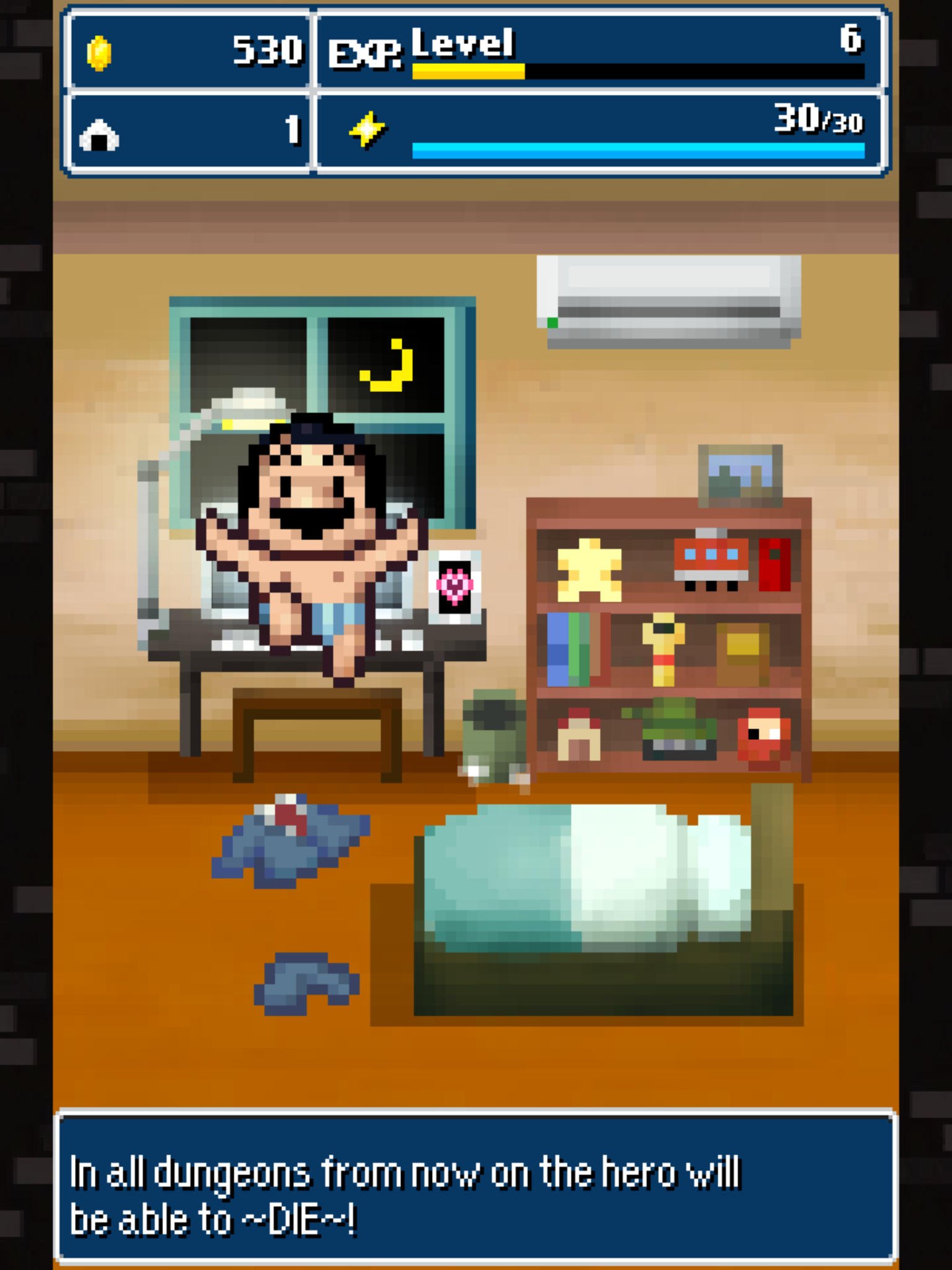
Making progress in the real game: When you complete a dungeon for the first time, you’ll return to Developer-Yamada’s apartment where he’ll usually implement new features or encounter an event of some type—NPCs frequently show up at his door and are then added to his game as characters (usually enemies, since most of the people he meets are jerks).
Yamada will also add a new area to his game, accessible under the Debug>Play menu. The first area you unlock is the Princess Tower, but after you beat this Yamada will create the Chairman’s Tower, Yamada the Wanderer, and so on. Completing new stages under the Play menu will progress you through Dandy Dungeon itself, getting you closer to finishing Developer-Yamada’s game and winning the heart of his neighbor, Maria.
Your current goal in Dandy Dungeon will always be to finish the newest stage under the Play menu (always at the top of the list) and you can see a reminder of this by tapping on Developer-Yamada and selecting “Schedule.”
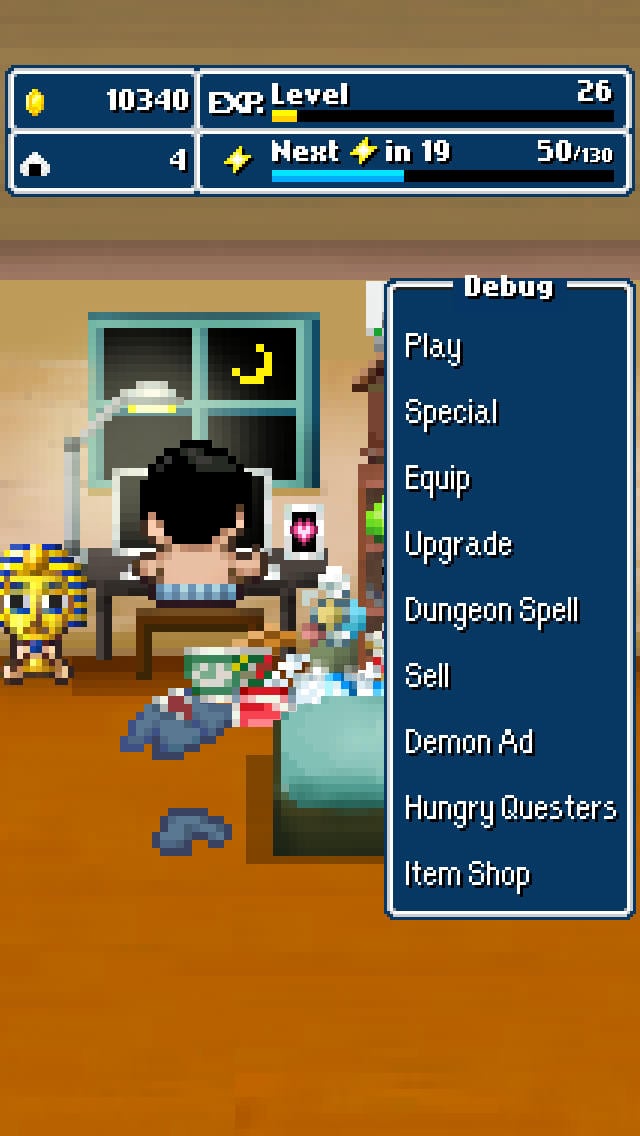
So what’re all these other options I’ve unlocked under “Debug”? As Dandy Dungeon progresses, you’ll also open up optional dungeons that are unrelated to the main story of the game. These come in a few different varieties:
First, there are “Hungry Questers” dungeons: these are unlocked after a hungry adventurer visits Yamada. If you select a Hungry Quester dungeon, you’ll be asked to “Recover” the quester so he can go dungeon-crawling. This will cost one of your premium rice balls and will send the quester off by himself automatically. You won’t play this dungeon yourself; instead you’ll simply reap the rewards after a few seconds of waiting. Different Questers have different rewards available, which will be visible on their screen after you select a mission.
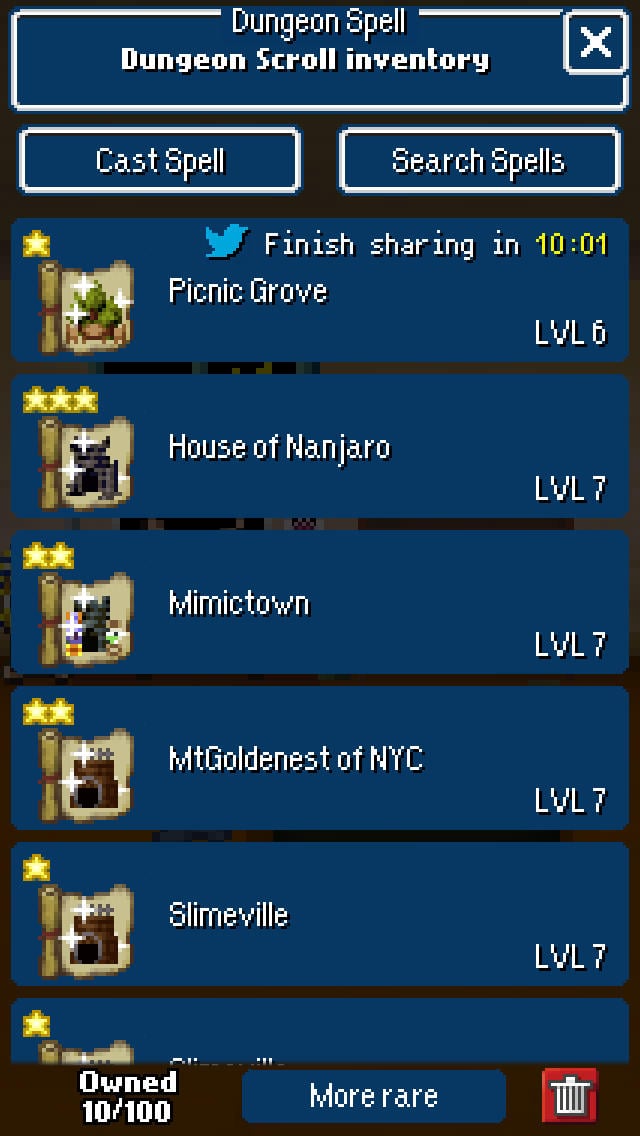
Second, there are “Dungeon Spell” dungeons: these are earned randomly while playing (Yamada’s mom mails them to him) or can be acquired by inputting codes other players share on Twitter. If you tap on a dungeon in the “Dungeon Spell” menu, you can “summon” it—or you can choose “Cast Spell” to input another player’s dungeon code. (This is what the “Cast Spell” on the main menu is for.)
Dungeons you summon in either of these ways will be available under “Special” in the Debug menu, but they can each only be played one time—if you complete the dungeon or flee from it, it will be removed from your Special list. These dungeons are a nice way to find treasure you might not have access to at your current point in the main dungeon list. They vary in difficulty and enemy types, but they’re generally short (3 floors) and you can preview the available treasures and monsters before playing as you would with any normal dungeons.
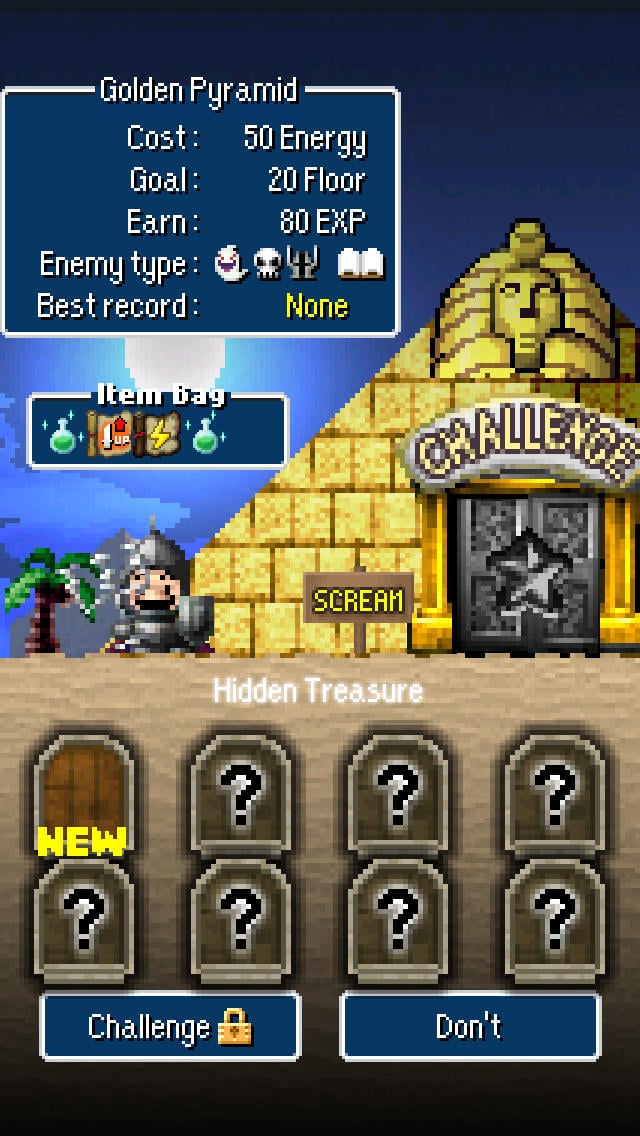
Finally, there is the “Golden Pyramid.” This is an extra-hard dungeon Yamada implements after meeting the “best programmer,” Aja. The Golden Pyramid can be played by spending one golden key (available in the Mamazon IAP shop) or five golden fragments (which can be won as rare treasure exploring other dungeons or for cleaning your room). It’s a massive dungeon with multiple levels made up of 20 floors each and filled with valuable treasure and difficult enemies. Although you likely won’t want to take on the Golden Pyramid until you’ve been playing awhile, you do keep some of the treasure you find in it even if you die in the attempt, which is not true for normal dungeons. Once added to the game you can view the Golden Pyramid from the “Special” menu.
All three types of bonus dungeons are mainly used for collecting additional and hard-to-find treasure that can be sold or used to upgrade/evolve your equipment.
Yamada’s too weak; I keep dying in the dungeon. Hero-Yamada gains levels by killing enemies in dungeons. Leveling up will increase his HP, Attack, and Defense and refill his health. Hero-Yamada’s levels are only retained in the current dungeon: once you complete or leave a dungeon, he will be reset to level 1. So every time you enter a dungeon from your apartment, you will be at level 1.
There are a few important activities to improve your chances of Hero-Yamada surviving. To begin with, try to fight every enemy you come across. This might seem counter-intuitive, but Hero-Yamada needs to level up within the dungeon so he can beat its strongest enemies on later floors. In a 5-floor dungeon, for instance, you should be able to level up numerous times before reaching the fifth floor. Because of this we also never take the shortcut birdcage when replaying past dungeons.
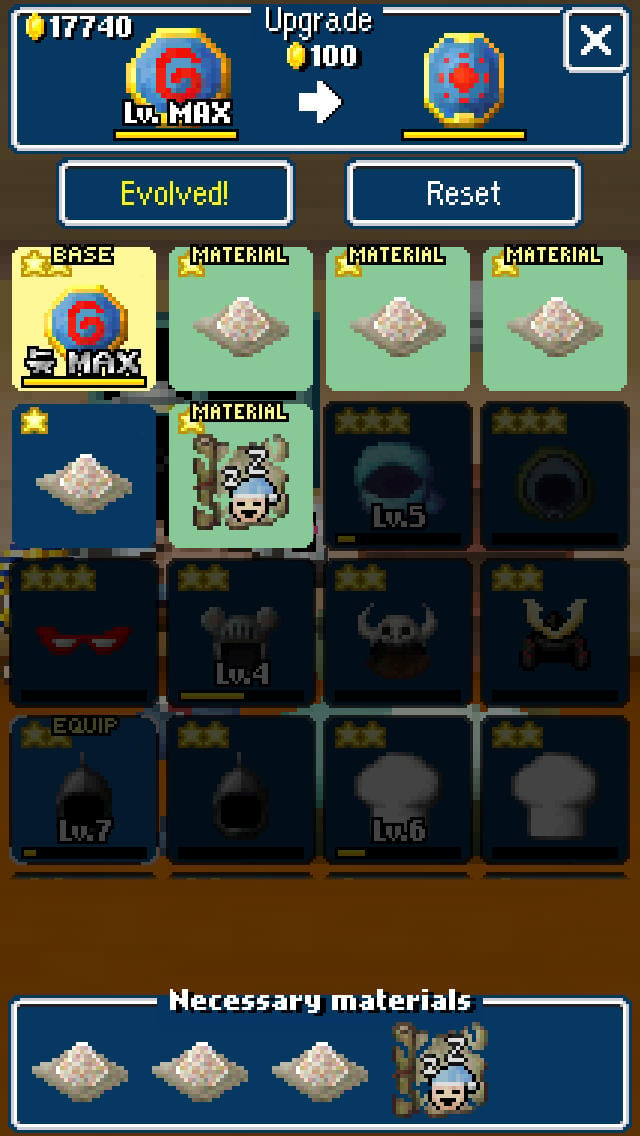
Be sure to upgrade your weapon and armor before entering a dungeon. You’ll unlock the Upgrade menu after Yamada creates the Chairman’s Tower. Upgrading weapons increases their attack power and can unlock special offensive skills, like “beast killer” or “fire attack.” Upgrading armor increases its defensive power. At max level, many weapons and armor can be evolved to their next stage if you have the right items for evolution. Equipping better items and upgrading them is the only way to improve Hero-Yamada’s stats permanently since he always begins dungeons over at level 1.
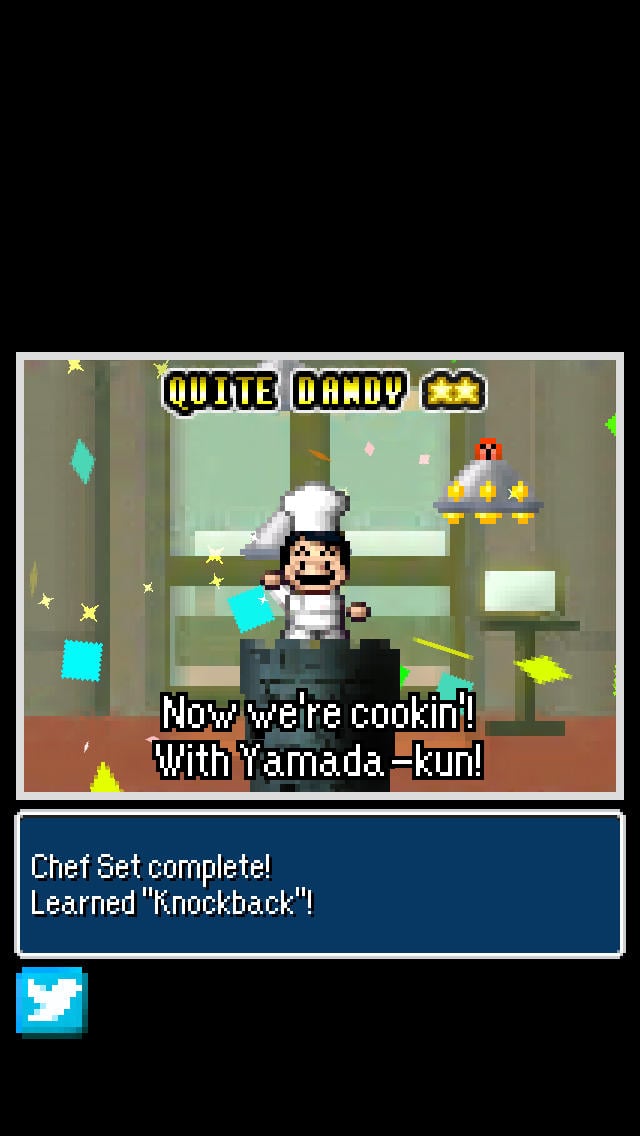
Use Dandy Sets to your advantage. Armor always belongs to a specific “set,” which can be viewed by holding your finger on an item and viewing its description. The Minotaur Head and Minotaur Pants, for instance, make up the Minotaur Set. When Hero-Yamada equips a full set of armor, he’ll receive a special bonus specific to that set as long as he continues wearing it. The Minotaur Set will give him +5 HP and the offensive “beast killer” skill. The Steel Set will give him +2 defense in addition to the defense each piece of armor offers. When you complete a set for the first time it will be added to the Dandy Collection menu and you can review sets and their bonuses here at any time.
Update: Thanks to other players sharing their Dandy Sets on Twitter, we’ve unlocked quite a few “Super” Dandy Sets that are combinations of different armor. For instance, equipping only the Leaf armor and no helmet or shield creates the “Naked Hero Set” worth +12 to HP and AGL. Or equipping the Chu Knight helmet and School Uniform armor unlocks the “Rat School Set” that gives +8 to HP and Critical and also gives Yamada the “Rat Hurricane” skill. You can get a hint at what a Dandy set might include by looking at the black outlines in the “Dandy Collections” menu available by tapping on Developer-Yamada. It’s usually pretty easy to tell which helmet a set requires–the Chu Knight ears have a distinct shape as does the Turd Hat, etc.–and then you can try equipping other items until a Set appears. These mixed items Super Sets are usually stronger than the standard matching set, so keep an eye out for them!
Take the right items into battle. In the equip menu you can also choose what usable items to bring with you, like Medicine, Thunderall Scroll, etc. You can only take five items total, but they can be duplicates (so you could take five Medicines if you wanted). If you see you’ll be facing magic-users on the dungeon prep screen, back out and equip the Magic Barrier item. If you are going up against a lot of undead enemies, try to equip a weapon with Holy Attack on it. If you need more details on an enemy before entering a dungeon, tap the book icon next to the “Enemy Type” data point on the “Go forth!” prep screen; this will usually tell you what types of enemies you’ll face in the dungeon and the weaknesses each type of enemy has.
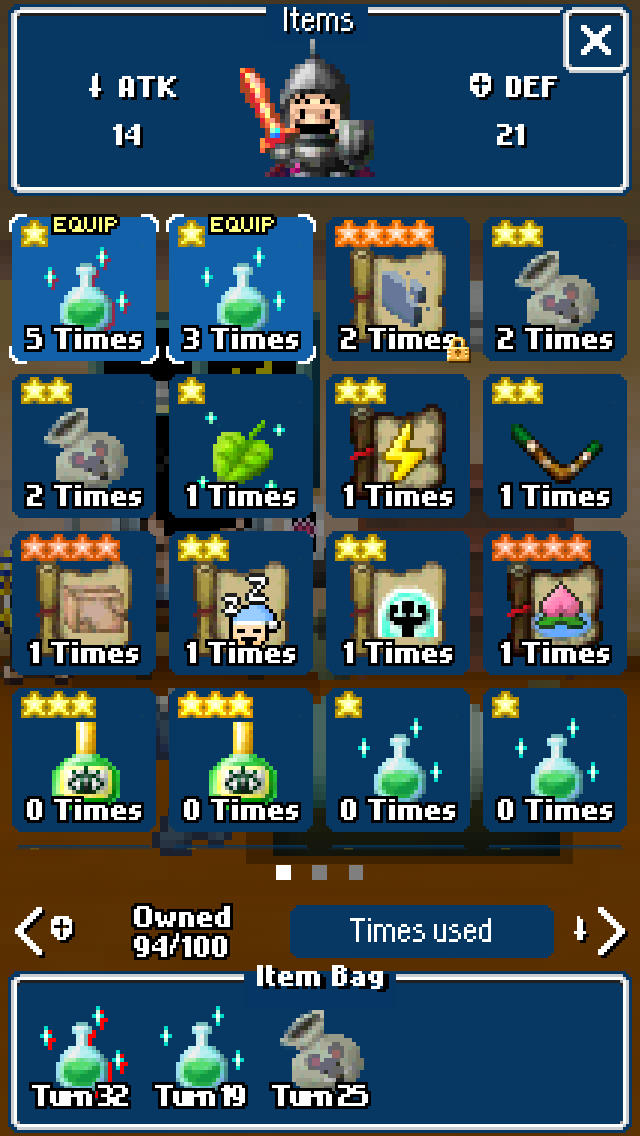
Why did my items break? Usable, non-equipment items like Medicine, Scrolls, and the other goods you can equip in your 5-item slots will all break after enough uses. You can use an item a total of 6 times before it breaks—that count maintains across dungeons, so you can use an item six times in one dungeon or once in six different dungeons, etc. After the sixth use, it will break and no longer be usable. Some items will give you a seventh use before breaking, but if you’ve used an item five times, be aware it’s very likely to break on the next use or two.
You can see how many times you’ve used an item by tapping on it while in a dungeon, or from the item equip menu in your apartment. If you sort by “times used” the menu will show you how many times each item has been used.
Items that are close to breaking will develop a pulsating red outline. In the image above you can see a Medicine we’ve used five times with a red glow next to a Medicine we’ve used three times which has no red around it. There is no way to repair a broken item; you can sell it for a reduced price or use it for equipment evolution.
Items that have been used multiple times will have a longer cooldown period than new items. The Medicine used five times will take 32 turns before it’s ready while a brand new Medicine with zero uses can be activated after only 12 turns.
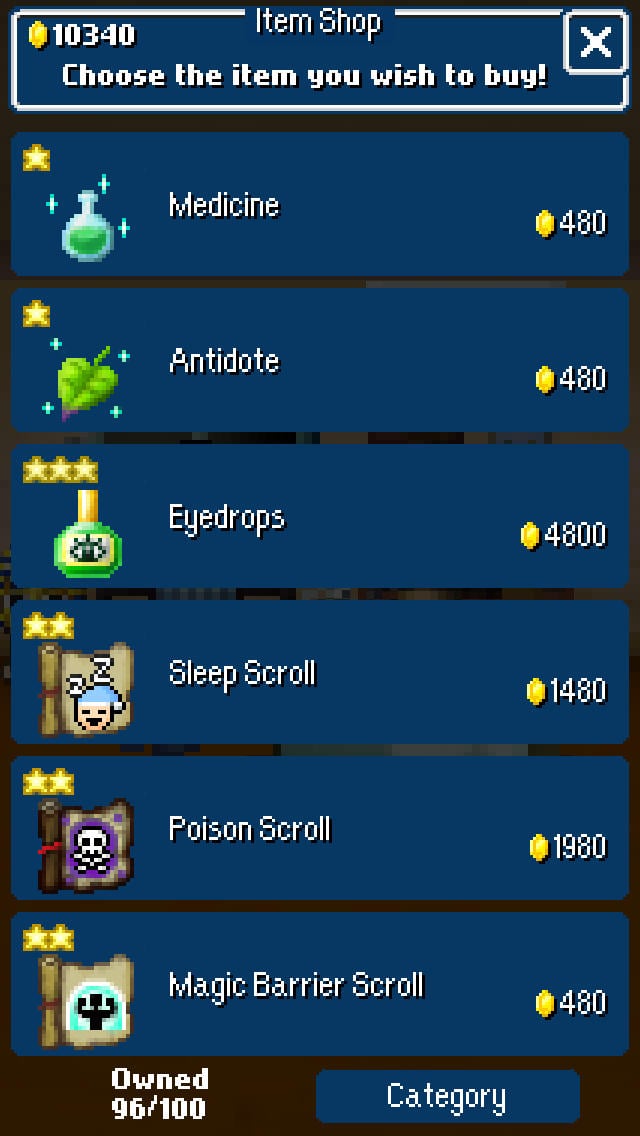
If your items break early in the game and you are having trouble finding replacements in the dungeon, keep moving forward. After the first few dungeons an Item Shop is added to the Debug menu which lets you purchase any items you’ve collected on previous trips. Because of this you should pick up every new item you come across and take it with you, even if it’s not quite as useful as what you currently have equipped. Once you pick an item up once it will be available in the Item Shop permanently.
Our recommended weapons/items for early-mid levels: At the beginning of the game you won’t have many choices in what you equip, but as you complete dungeons and collect treasure, you’ll have tons of weapons, armor, and usable items in your arsenal. The Fire Sword (which can be won in Dungeon #3, Yamada the Wanderer), is a great early weapon that stays strong for quite awhile. Its Fire Attack ability, which is learned by upgrading the sword to level 5, makes it strong against nature and undead enemies, both of which you’ll encounter quite a bit. Weapons with longer reach—like the Beast Whip (available in Dungeon #5, Corpsewoods) or Naginata (Dungeon #9, Feudal Basement)—attack 2 squares ahead and allow Yamada to get the drop on melee enemies.
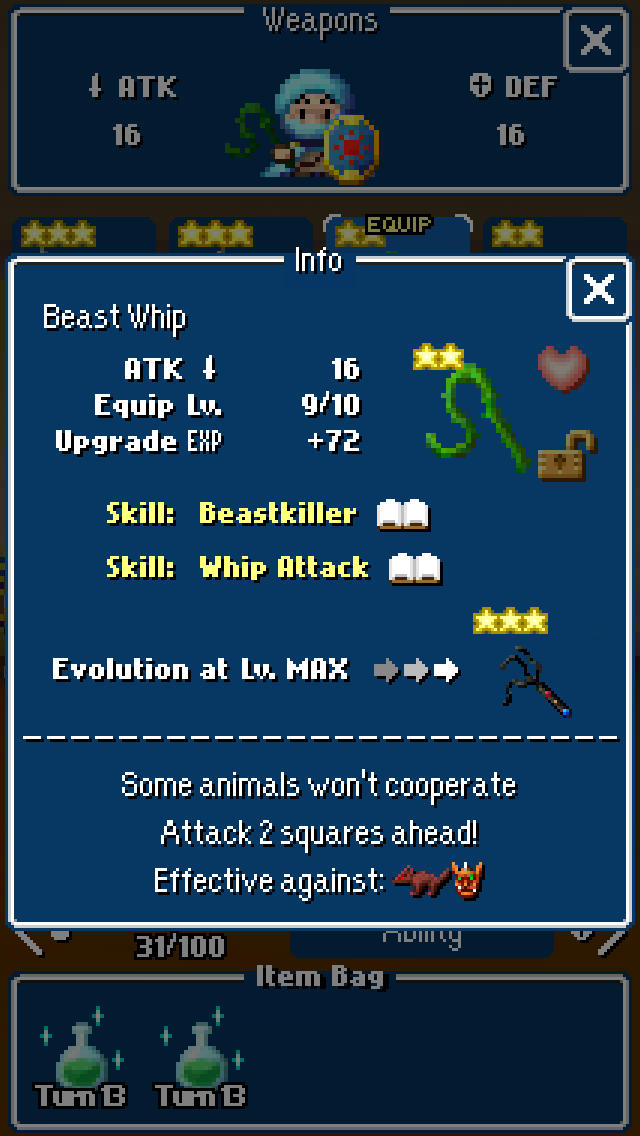
We don’t recommend two-handed, low-accuracy weapons like axes; enemies in this game are typically too fast and dodge too easily for a low-accuracy weapon and the added defense of a shield is too helpful to give up. A lower-damage, higher-accuracy weapon will generally be better than the opposite.
Our favorite usable items for the first 1-10 levels in the game are Medicine (of course), Sleep Scroll, and Ratbag. The Ratbag is almost essential in forest dungeons: it not only sets off traps in advance so Yamada won’t be harmed by them but also reveals areas hidden under trees so you can see what paths are open. It also does minimal (1 HP) damage to most enemies.
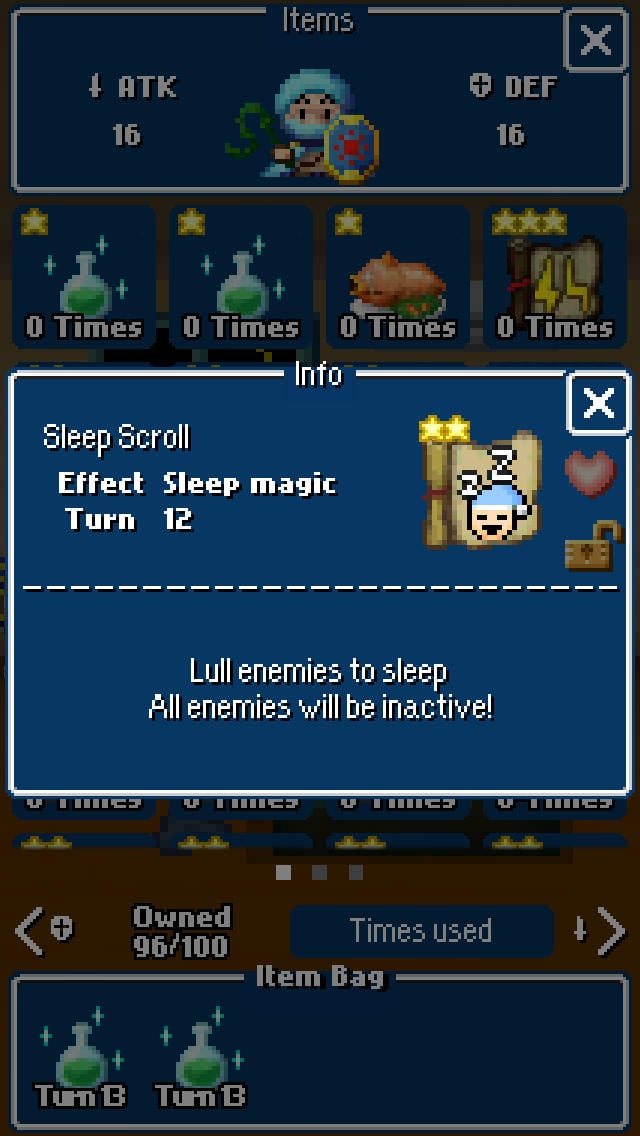
A lot of early dungeon enemies are susceptible to Sleep and the Sleep Scroll will affect any sleep-able enemy on-screen. This is great for preventing long-range enemies like archers from getting extra hits in, stops fairies from healing their friends, and just gives Yamada a chance for the first hit.
If you don’t have the Item Shop yet or don’t have enough coins to buy the items you need, you can replay past dungeons and hope to find items to pick up. Item drops are random but certain dungeons are more likely to contain specific items. The only real way to see what dungeons can contain what items is by viewing the item in the evolve upgrade screen: for example, hold-tap on a weapon that can be evolved. Then tap on its evolution picture. At the bottom of this next screen you’ll see the items required for the evolution, and if you tap on these you’ll see what dungeons are likely to have them.
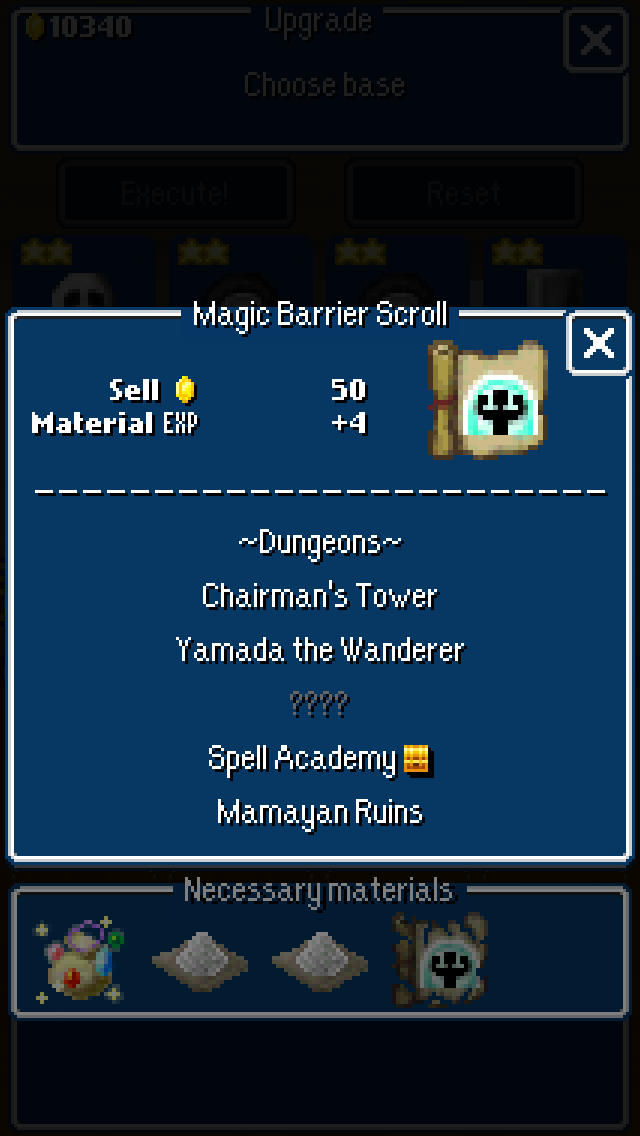
Here are just a few items and which dungeons you can find them in:
- Ratbag: Yamada the Wanderer, Corpsewoods, Aja’s Tower
- Sleep Scroll: Yamada the Wanderer, House of Nanjaro, Golden Pyramid
- Poison Scroll: The Local Sewer, Feudal Basement, Tokugawa Cave
- Bug Spray: Feudal Basement, Skittery Park, Bee Garden
- Morph Scroll: Fungus Forest, Corpsewoods, Queen’s Castle, Golden Pyramid
- Magic Barrier Scroll: Chairman’s Tower, Yamada the Wanderer, Spell Academy, Mamayan Ruins
- Antidote: Chairman’s Tower, Yamada the Wanderer, Picnic Grove, Asparaguster’s Ranch
- Fire Scroll: Corpsewoods, Queen’s Castle, Bistro Porkpork, Fire Golem Cave, Golden Pyramid
How to “grind” if you’re having trouble beating a dungeon: Since Hero-Yamada does not retain levels outside of a dungeon, “grinding” in this game does not involve leveling up. Instead, grinding is more about collecting usable items (see above) and items for upgrading your weapons and armor to a higher level, as well as coins to make those upgrades.
We really like grinding in the dungeon Yamada the Wanderer for picking up usable items. Once bosses begin reappearing in past dungeons (another feature that Developer-Yamada implements as you progress), grinding Chairman’s Tower or Queen’s Castle is helpful because you’ll earn their related Stone which is worth 200 EXP when upgrading. You don’t want to grind dungeons that are really difficult for you as you’ll end up wasting all your items just to complete them again. The goal is to replay a dungeon spending little more than the energy it costs to enter and possibly a use or two of easy to find items, like Medicine or Ratbag.
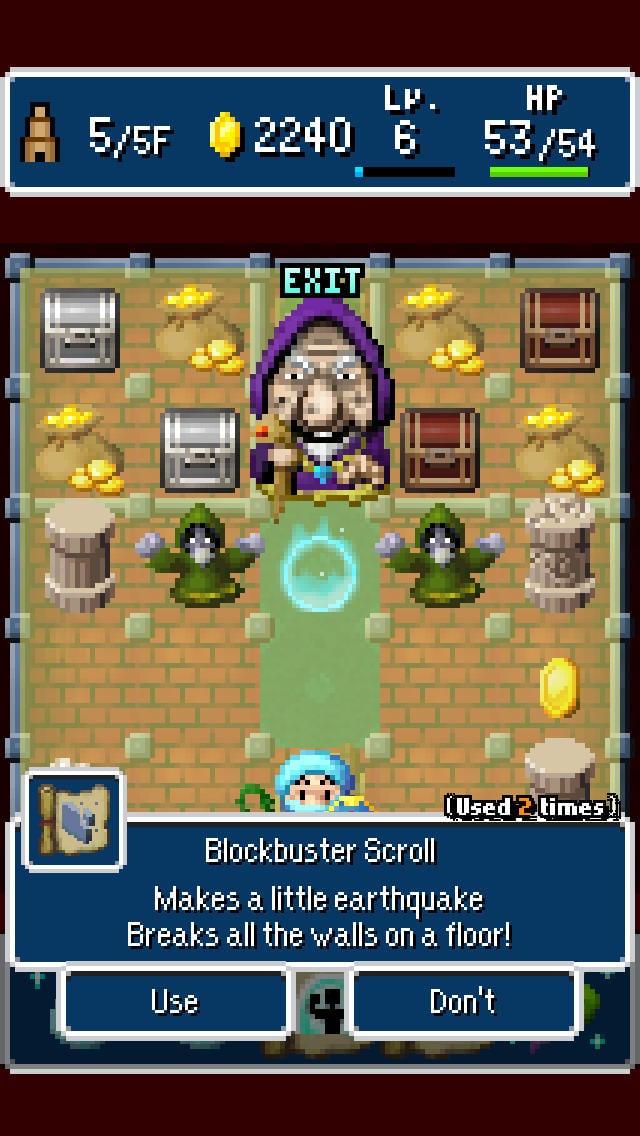
I can’t reach the treasure chests on the last floor of Chairman’s Tower. The final room of Chairman’s Tower has a walled-off section at the top with lots of shiny treasure chests. You won’t be able to access these chests for awhile—you need the rare Blockbuster Scroll, which destroys all walls on a floor and gives you access to areas Yamada previously could not reach. We randomly happened upon one of these scrolls when replaying Yamada the Wanderer, but they show up rarely and are prohibitively expensive in the Item Shop.
If some area of a dungeon seems obviously inaccessible, it’s likely you need a type of magic or power you simply haven’t discovered yet and you’ll need to come back later. You’ll typically still get the Perfect Clear bonus for these floors even if you don’t make it beyond the walls.
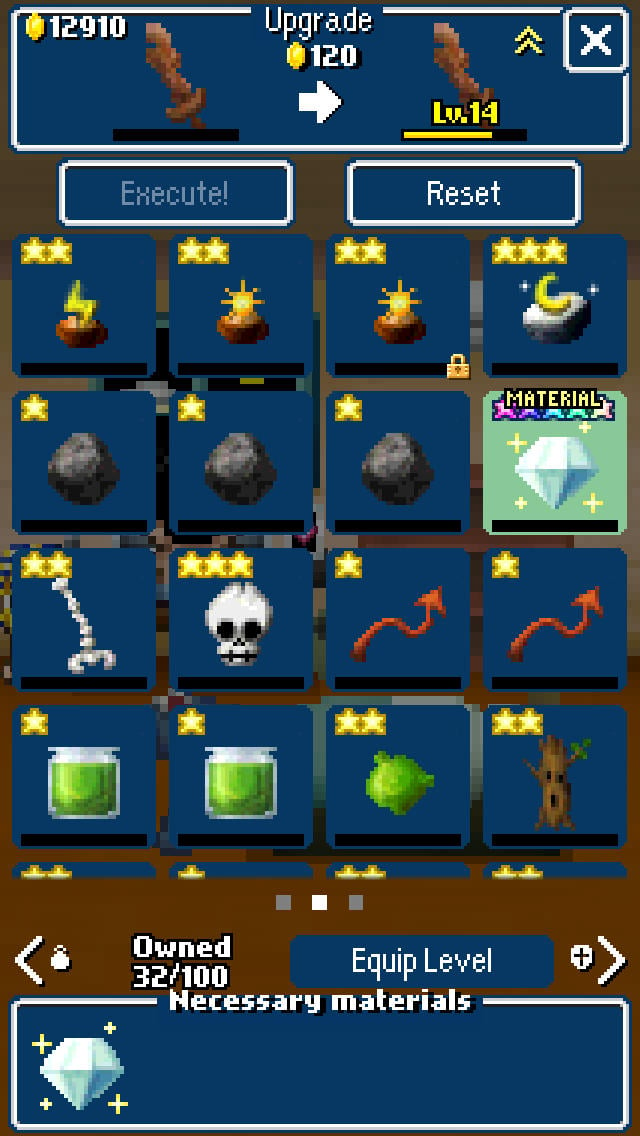
Upgrade items with high EXP ingredients first. Upgrading items has a somewhat fixed cost that increases with every level they improve and each time you upgrade. A level one, one-star weapon will cost 80 coins per item to upgrade—so if you use all five upgrade slots on your first time upgrading, it will be 400 coins. You could potentially max out your weapon on this single upgrade for only 400 coins. However, if you don’t, the next time you upgrade each item will cost twice as much at 160 coins. And that amount will double with every level. Those prices are higher for higher ranked items, so a 3-star weapon will cost 120 coins per item on its first upgrade, which then doubles, and so on. Basically, the fewer times you upgrade the fewer items you use, the cheaper the process will be. In the image above, you can see we are upgrading a level one, 1-star sword with a diamond: this would get the sword to level 14 but only cost the usual level one amount of 120 coins for one item.
Don’t sell upgraded equipment; use it for other upgrades. If you no longer need an item you’ve upgraded previously, do not sell it—upgraded equipment does not sell for any more than its base level, but it does retain the EXP that went into it. For instance, both a level one Beast Whip and level nine will sell for 40 coins each. If used for upgrading another weapon or piece of armor, the level one Beast Whip will give 8 EXP to the other item while the level nine will give 72 EXP.
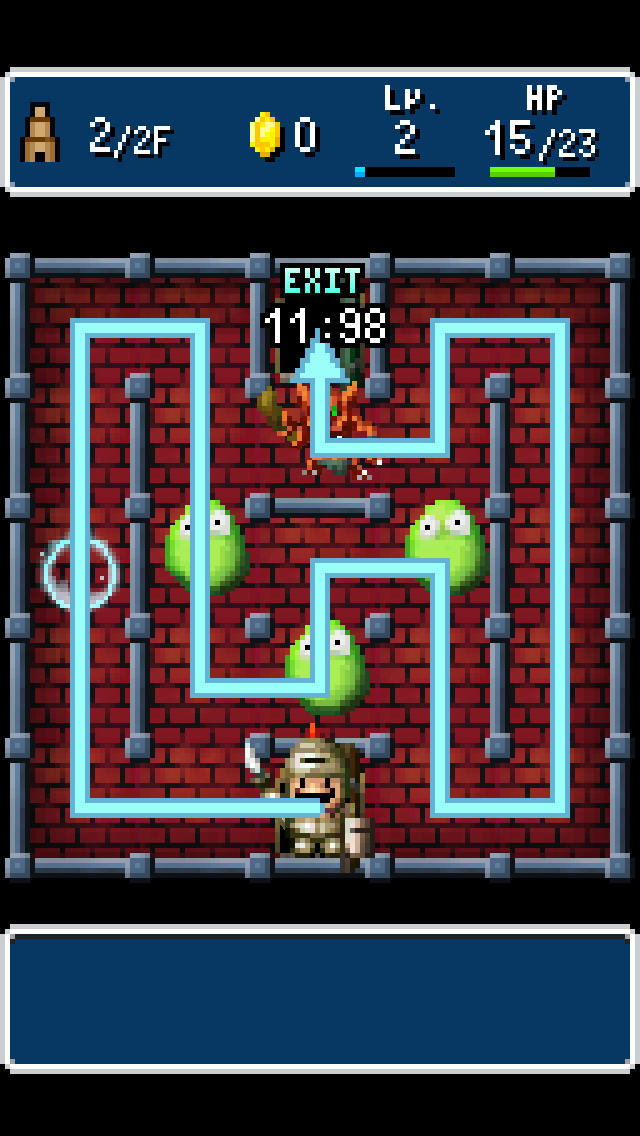
Always try to get “Perfect Clear” on dungeon floors. A “Perfect Clear” on a floor means Hero-Yamada walked over every tile he can reach. There are two benefits to this: first, any empty tiles Yamada misses will turn into fire and hurt him when he reaches the exit, so this avoids additional damage. Second, you’ll earn a bonus reward for every “Perfect Clear” you receive. Sometimes this is small, like 50 coins, but sometimes it’s a useful item or much larger coin prize. Additionally, you can only get the gold trophy and related reward for an entire dungeon by Perfect Clearing every floor in it.
Plan out your path before you start drawing your line. As soon as you begin drawing from Hero-Yamada, a countdown timer begins. You have 20 seconds (on most dungeons) to complete your path to the exit. If you don’t finish before that time runs out, fireballs will begin shooting at you and reducing your HP. These won’t stop until you are dead or until you complete the line. However, before you actually start drawing you have unlimited time to plan your route, tap on enemies or objects to view information about them, etc. Also remember that the only time you can flee from a dungeon is when Yamada is standing on the entrance and you have not drawn your line yet (tap on him and the door icon to leave the dungeon).
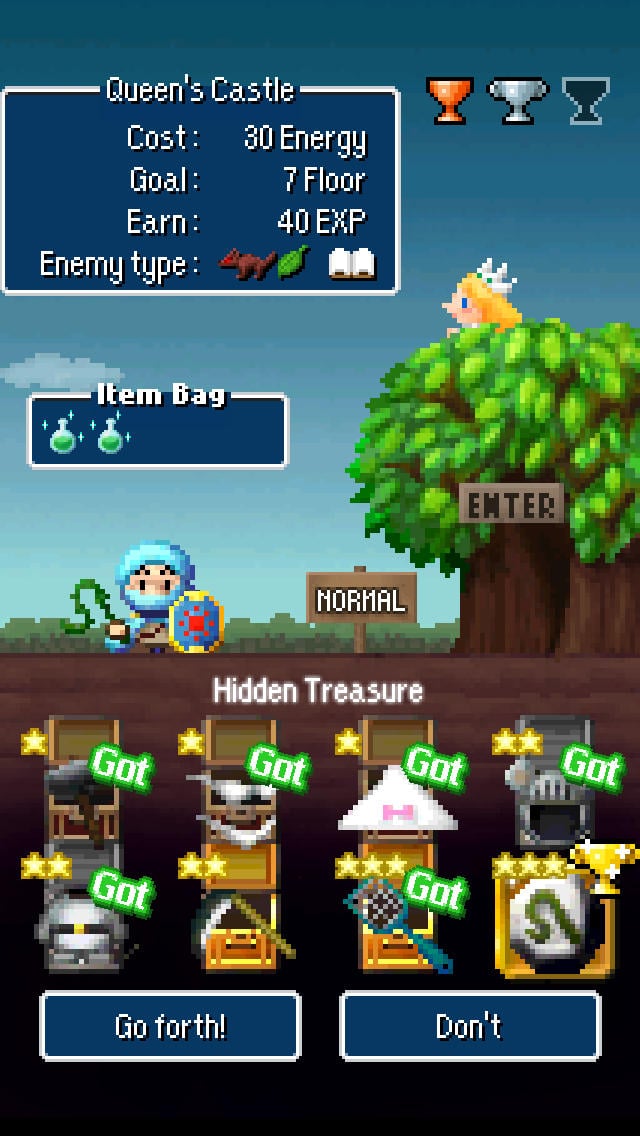
Treasure drops in dungeons are somewhat random. If you’re having trouble getting a gold trophy on a dungeon because you have not collected all the different types of treasure it offers, keep replaying it. The treasure you get is random and higher level chests like gold and platinum will show up less often. You might get all the treasure on your first run or it may take a dozen+ tries before you get the final missing piece. For instance, we have played the Queen’s Tower about ten times and have gotten the Panties tons of times, but the Grass Scythe has never dropped. Keep in mind the note above about the Chairman’s Tower—if there’s an area you obviously can’t reach, that may be holding you back from getting all the treasure at the moment. But if you have touched every tile on every floor, it’s simply a matter of playing the dungeon over until the right treasure appears.
You can fast-forward the game, but be careful using this on difficult dungeons. Dandy Dungeon lets you fast-forward most in-game action by tapping and holding on the screen. This allows you to speed through cutscenes in Yamada’s apartment or speed up his journey through a dungeon floor. However, if you do this in a dangerous area Yamada might be injured and killed before you get a chance to heal him. Be aware of enemies that might give you trouble and let Hero-Yamada handle those enemies at his normal pace.
How do I clean Yamada’s room? Once his room is dirty enough, Developer-Yamada will automatically clean it the next time you open the game. You’ll earn a cleaning stamp which will award prizes after you get enough stamps (including golden fragments for the Pyramid!), and Yamada will find some sort of item in the pile of garbage. If you miss a day and two days’ worth of trash piles up, Yamada will clean slightly longer and you’ll get two stamps/two items.
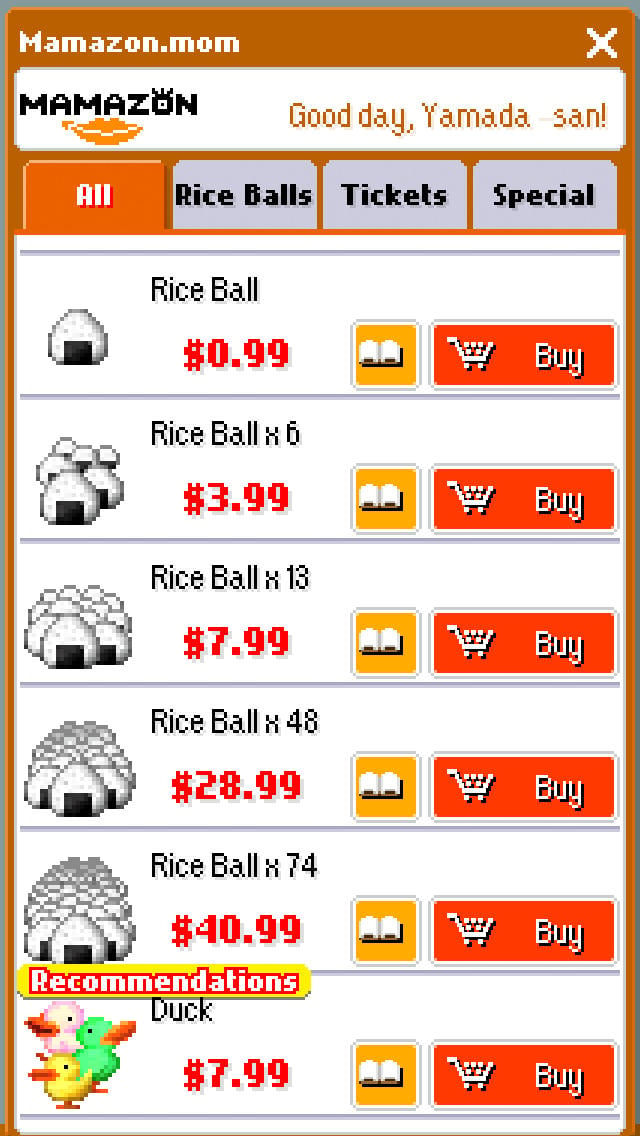
What are the in-app purchases in the Mamazon store? Mamazon sells rice balls, the premium currency used to revive if you die in a dungeon and to feed Hungry Questers to they can take on their own dungeons. The duck essentially removes the energy meter and lets you send Hero-Yamada into dungeons as often as you’d like without waiting for your energy to refill. (If you buy the duck you also get an inventory +30 set.) The storage expansion ticket adds slots to your inventory so you can hold more weapons/armor/items. Note: this is your primary storage where things like upgrade stones, helmets, extra items, etc. are kept. This is not your in-dungeon storage which always only allows you to hold five items at a time. Finally, once you unlock the Golden Pyramid, Mamazon will sell Golden Keys, which give you one attempt at the Golden Pyramid per key.
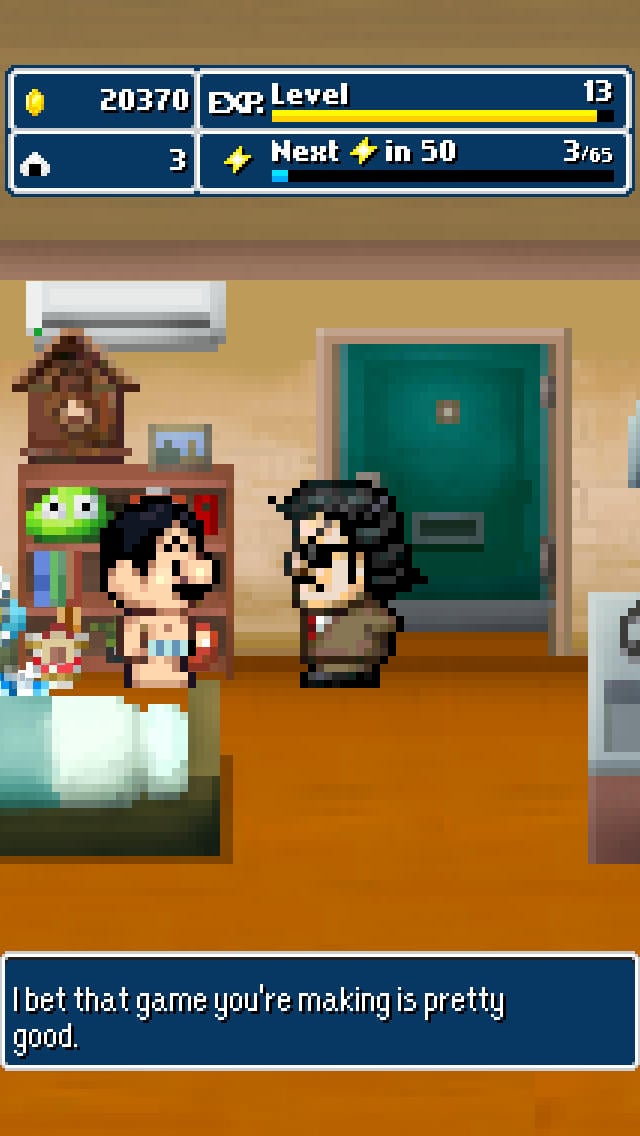
People keep randomly showing up at Yamada’s door? When you’re completing the primary dungeons and making progress in Dandy Dungeon, you’ll have story-based encounters in Yamada’s apartment. Even when you’re not making progress and just replaying past areas or clearing Special dungeons, you’ll still get visitors just for fun. Maria will sometimes stop by and share info about herself, the mailman will bring you new Special dungeons, Hungry Questers will pop in and tell you about their backstories. These encounters don’t really mean anything, they’re just like NPC conversations in any RPG—world-building and Yamada-punching fun.
More articles...
Monopoly GO! Free Rolls – Links For Free Dice
By Glen Fox
Wondering how to get Monopoly GO! free rolls? Well, you’ve come to the right place. In this guide, we provide you with a bunch of tips and tricks to get some free rolls for the hit new mobile game. We’ll …Best Roblox Horror Games to Play Right Now – Updated Weekly
By Adele Wilson
Our Best Roblox Horror Games guide features the scariest and most creative experiences to play right now on the platform!The BEST Roblox Games of The Week – Games You Need To Play!
By Sho Roberts
Our feature shares our pick for the Best Roblox Games of the week! With our feature, we guarantee you'll find something new to play!Type Soul Clan Rarity Guide – All Legendary And Common Clans Listed!
By Nathan Ball
Wondering what your odds of rolling a particular Clan are? Wonder no more, with my handy Type Soul Clan Rarity guide.







